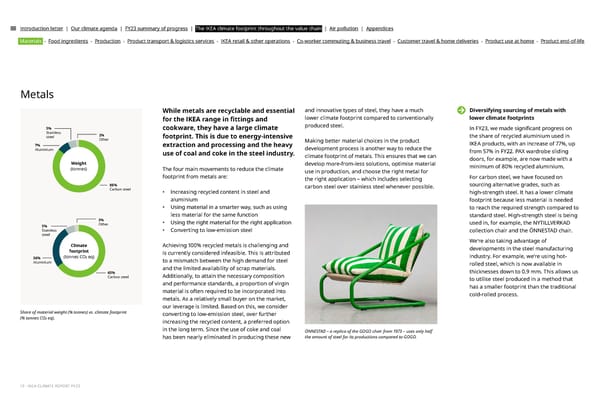Introduction letter | Our climate agenda | FY23 summary of progress | The IKEA climate footprint throughout the value chain | Air pollution | Appendices Materials - Food ingredients - Production - Product transport & logistics services - IKEA retail & other operations - Co-worker commuting & business travel - Customer travel & home deliveries - Product use at home - Product end-of-life Metals While metals are recyclable and essential and innovative types of steel, they have a much Diversifying sourcing of metals with lower climate footprint compared to conventionally lower climate footprints for the IKEA range in 昀椀ttings and 5% cookware, they have a large climate produced steel. Stainless In FY23, we made signi昀椀cant progress on steel 2% footprint. This is due to energy-intensive the share of recycled aluminium used in Other Making better material choices in the product IKEA products, with an increase of 77%, up 7% extraction and processing and the heavy development process is another way to reduce the Aluminium use of coal and coke in the steel industry. from 57% in FY22. PAX wardrobe sliding climate footprint of metals. This ensures that we can doors, for example, are now made with a Weight develop more-from-less solutions, optimise material minimum of 80% recycled aluminium. (tonnes) The four main movements to reduce the climate use in production, and choose the right metal for footprint from metals are: the right application – which includes selecting For carbon steel, we have focused on 86% carbon steel over stainless steel whenever possible. sourcing alternative grades, such as Carbon steel • Increasing recycled content in steel and high-strength steel. It has a lower climate aluminium footprint because less material is needed • Using material in a smarter way, such as using to reach the required strength compared to less material for the same function standard steel. High-strength steel is being 3% • Using the right material for the right application used in, for example, the NYTILLVERKAD 5% Other Stainless • Converting to low-emission steel collection chair and the ÖNNESTAD chair. steel Climate Achieving 100% recycled metals is challenging and We're also taking advantage of footprint is currently considered infeasible. This is attributed developments in the steel manufacturing industry. For example, we're using hot- 26% (tonnes CO2 eq) to a mismatch between the high demand for steel Aluminium rolled steel, which is now available in and the limited availability of scrap materials. thicknesses down to 0.9 mm. This allows us 65% Additionally, to attain the necessary composition Carbon steel to utilise steel produced in a method that and performance standards, a proportion of virgin has a smaller footprint than the traditional material is often required to be incorporated into cold-rolled process. metals. As a relatively small buyer on the market, our leverage is limited. Based on this, we consider Share of material weight (% tonnes) vs. climate footprint converting to low-emission steel, over further (% tonnes CO2 eq). increasing the recycled content, a preferred option in the long term. Since the use of coke and coal ÖNNESTAD – a replica of the GOGO chair from 1973 – uses only half has been nearly eliminated in producing these new the amount of steel for its productions compared to GOGO. 13 - IKEA CLIMATE REPORT FY23
 IKEA CLIMATE Report FY23 Page 12 Page 14
IKEA CLIMATE Report FY23 Page 12 Page 14